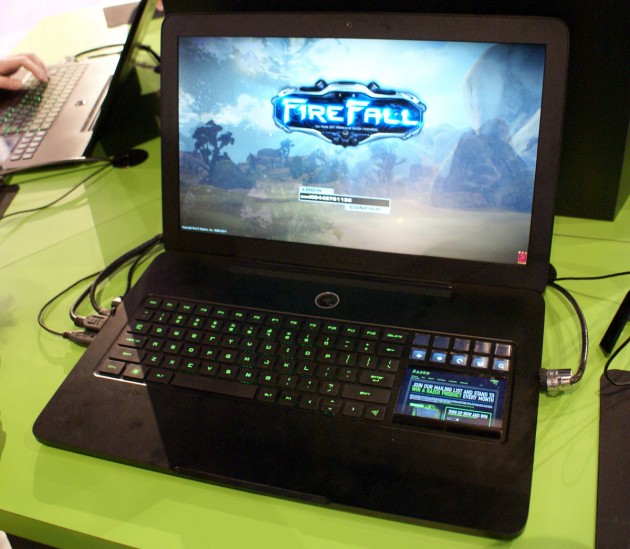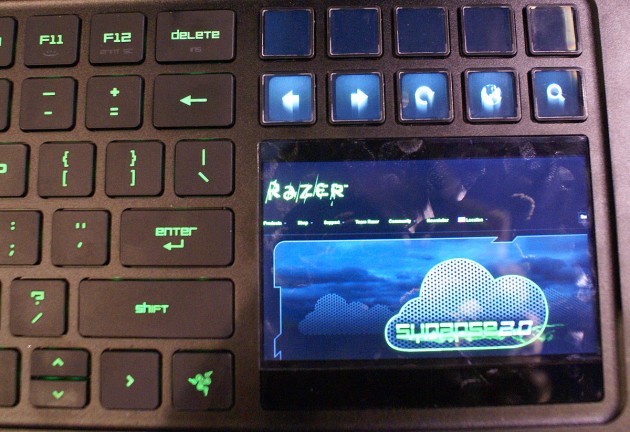One of the bigger buzz stories of CES 2012 was the announcement of Razer’s Project Fiona. This tablet with a controller attached promised to usher in a new era of mobile computing. The device itself commanded a large portion of Razer’s CES booth, with a glassed-over podium showcasing a mockup of the device sitting directly in the middle of the spacious area. Journalists huddled around the glass in throngs, eagerly snapping photos of the bulky device. While the rest of the world gave itself an aneurysm over this bad Shrek reference, I approached the booth looking for something our readers actually cared about—the Razer Blade gaming laptop.
The Razer Blade is Razer’s attempt at constructing a true, small form factor gaming laptop. When announced, it stirred quite the discussion amongst Icrontic staff and readers alike. The laptop has garnered criticism thanks to its absurdly high MSRP, considering its lack of top-tier hardware. Conversely, the laptop features a touchscreen LCD panel that can be changed to, well, anything you could possibly want. Keypad, web browser, YouTube, images—the possibilities are broad.
As I walked up to take a look at the Blade, a large screen above me played a video of Razer CEO Min-Liang Tan talking on the merits of the Razer Blade. “True gaming laptops do not exist today.” he declared. He went on to explain that “gaming laptops” feature form factors large enough to be considered a briefcase, and don’t deliver on the promise of easy gaming on the go. The Razer Blade is their answer—the first true gaming laptop.
A True Gaming Laptop?
Except it really isn’t. Not by PC gamer standards, anyways. The form factor is nice, at less than an inch thin and weighing in at a touch under seven pounds. The guts on the inside, however, do not scream high end. The Blade features a dual core Intel Core i7 processor and an NVIDIA GeForce GT 555M. This laptop will not run games like Battlefield 3 and Crysis 2 at 60FPS+ with max detail settings. In fact, at the booth they were showing games like League of Legends, Firefall and Star Wars: The Old Republic. In the case of Firefall, framerates weren’t always at a smooth 60FPS.
It raises a serious question—for a company building the first “true” gaming laptop, why not offer a GeForce GTX series GPU and a quad core processor? PC gamers want the best, and with the Razer Blade, the best isn’t even an option. When I asked why Razer made this decision, I was told that they were more concerned with form factor than ultimate performance. The rep I spoke to even said that the laptop will game at 30-60FPS without problems. An odd statistic, as most PC gamers that I know find 30FPS in games to be unacceptable. I asked if they had run 3D Mark on it yet, but I was told that they were not releasing such information. All of this in a laptop that carries an MSRP of $2,799? Absolute madness.
The upside
The laptop does have one major redeeming feature, however, and that is the integrated touchscreen LCD that everyone keeps talking about. After only a few short moments of playing around with the touchscreen, I already knew it to be a game changer. If there were one reason to own the Razer Blade despite its rather severe shortcomings, it is this touchscreen.
This touchscreen LCD has a multitude of purposes. At the surface is a clear touchscreen, with a high resolution, full color LCD screen under it. Above it is a row of 10 clear keys with small LCDs embedded in them. These keys act as selectors for what is displayed in the screen of the main touchscreen. It can be toggled to function as a trackpad for controlling the mouse, a numberpad for a more traditional keyboard layout, hotkeys for the specific game being played, settings for the trackpad and keyboard, and more.
Perhaps the most impressive capability of the LCD is its browser function. The LCD can be turned into a smartphone-esque web browser, allowing you to view webpages while you play games full screen. The pages can zoom in and out for easier reading by pinching, exactly as touchscreen phones do today. The keyboard also has a YouTube app that allows the viewing of videos while gaming in full screen. Such uses for the LCD would allow players to have game guides, FAQs, and instructional videos pulled up for reference without having to alt+tab out of the game. As a League of Legends player, the thought of viewing MOBAFire guides with a quick glance down to my keyboard while I play makes me salivate. This is brilliant technology.
I was told that the LCD screen was extensible with apps, meaning gamers can customize the things their keyboard can switch to by adding and removing specific apps. The Razer Blade comes with software that lets users easily change up the LCD layout. Furthermore, Razer will be releasing an SDK with the next month or so that will allow developers to code their own apps for use in the keyboard. The potential for this LCD technology is tremendous.
Unlike all traditional laptops that put the trackpad below the keyboard. Razer have intuitively placed the trackpad LCD surface to the right of the keyboard, making mouse-less gaming much more natural feeling. I couldn’t tell if this placement made casual computer use more or less comfortable in my quick demo, but it certainly helped in the case of gaming.
There are certain drawbacks to the LCD. Much like modern smartphones, the touchscreen’s glossy surface is prone to copious fingerprints, smudges, and scratching. As this is the main trackpad for the laptop, the surface quickly becomes gross (after days of CES use, the demo units were smudgy enough to make my anti-fingerprint obsession kick into overdrive). The durability should also be a concern, as the LAN-going gamer may need to treat this device with greater care than typical hardware.
So the Razer Blade has a lot of issues, and its biggest redeeming feature is its awesome integrated LCD Touchscreen. So what are gamers to do that aren’t willing to shell out nearly three grand just to get their hands on this technology? Fortunately, Razer seems to have considered the problem, and they’ve introduced a product that speaks to the rest of us.
LCD on a keyboard
Razer were showing off their new Star Wars: The Old Republic Gaming Keyboard at their booth. This sleek gaming keyboard integrates the exact same touchscreen LCD technology found on the Razer Blade, positioned to the right of the QWERTY keys. The full capabilities have survived intact. The touchscreen is a wonderful compliment to the keyboard’s other gaming-focused features, such as multi-color backlighting, custom macro keys, incredibly smooth feeling keycaps, and extremely fast polling times. Unlike the Razer Blade, the Old Republic Gaming Keyboard has a much more sensible price tag at $249. It is planned to be released in late February.
I walked away from the Razer booth with a feeling that the company is definitely on to something, and it isn’t in the tablet space. Integrating high technology like this touchscreen into peripherals that haven’t really changed in decades is a bold move that will lead to interesting new input capabilities. Sure, the Razer Blade is hardly a step in the right direction with its steep price tag and mediocre hardware, but the technology there is astounding and exciting. Even more exciting is the fact that Razer will embrace the developer community to push their technology even further. And even though the LCD has only yet found its way to desktop systems through a Star Wars branded keyboard, it is great to know that Razer are not keeping this intuitive idea locked up for their high dollar, top-shelf laptop products. The company is definitely thinking ahead with the touchscreen LCD, and PC gamers everywhere should find plenty of reason to get excited about that.











 Articles RSS
Articles RSS